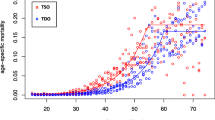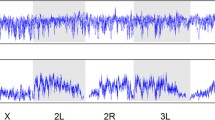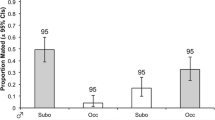Abstract
Founder effects during colonization of a novel environment are expected to change the genetic composition of populations, leading to differentiation between the colonizer population and its source population. Another expected outcome is differentiation among populations derived from repeated independent colonizations starting from the same source. We have previously detected significant founder effects affecting rate of laboratory adaptation among Drosophila subobscura laboratory populations derived from the wild. We also showed that during the first generations in the laboratory, considerable genetic differentiation occurs between foundations. The present study deepens that analysis, taking into account the natural sampling hierarchy of six foundations, derived from different locations, different years and from two samples in one of the years. We show that striking stochastic effects occur in the first two generations of laboratory culture, effects that produce immediate differentiation between foundations, independent of the source of origin and despite similarity among all founders. This divergence is probably due to powerful genetic sampling effects during the first few generations of culture in the novel laboratory environment, as a result of a significant drop in N e. Changes in demography as well as high variance in reproductive success in the novel environment may contribute to the low values of N e. This study shows that estimates of genetic differentiation between natural populations may be accurate when based on the initial samples collected in the wild, though considerable genetic differentiation may occur in the very first generations of evolution in a new, confined environment. Rapid and significant evolutionary changes can thus occur during the early generations of a founding event, both in the wild and under domestication, effects of interest for both scientific and conservation purposes.



Similar content being viewed by others
References
Ackermann M., Bijlsma R., James A. C., Partridge L., Zwaan B. J. and Stearns S. C. 2001 Effects of assay conditions in life history experiments with Drosophila melanogaster. J. Evol. Biol. 14, 199–209.
Benjamini Y. and Yekutieli D. 2001 The control of the false discovery rate in multiple testing under dependency. Ann. Stat. 29, 1165–1188.
Boileau M. G., Hebert P. D. N. and Schwartz S. S. 1992 Non-equilibrium gene frequency divergence: persistent founder effects in natural populations. J. Evol. Biol. 39, 25–39.
Bryant E. H., McComas S. A. and Combs L. M. 1986 The effect of an experimental bottleneck upon quantitative genetic variation in the housefly. Genetics 114, 1191–1211.
Carson H. L. and Templeton A. R. 1984 Genetic revolutions in relation to speciation phenomena – the founding of new populations. Annu. Rev. Ecol. Syst. 15, 97–131.
Charlesworth B. 2009 Fundamental concepts in genetics: effective population size and patterns of molecular evolution and variation. Nat. Rev. Genet. 10, 195–205.
Crawford N. G. 2010 SMOGD: software for the measurement of genetic diversity. Mol. Ecol. Res. 10, 556–557.
Dlugosch K. M. and Parker I. M. 2008 Founding events in species invasions: genetic variation, adaptive evolution, and the role of multiple introductions. Mol. Ecol. 17, 431–449.
Excoffier L. and Ray N. 2008 Surfing during population expansions promotes genetic revolutions and structuration. Trends Ecol. Evol. 23, 347–351.
Excoffier L., Smouse P. E. and Quattro J. M. 1992 Analysis of molecular variance inferred from metric distances among DNA haplotypes: application to human mitochondrial DNA restriction data. Genetics 131, 479–491.
Gilchrist G. W., Huey R. B., Balanyà J., Pascual M. and Serra L. 2004 A time series of evolution in action, a latitudinal cline in wing size in South American Drosophila subobscura. Evolution 58, 768–780.
Goodnight C. J. 1988 Epistasis and the effect of founder events on the additive genetic variance. Evolution 42, 441–454.
Goudet J. 1995 FSTAT (ver. 2.9.3.): a computer program to calculate F-statistics. J. Hered. 86, 485–486.
Gregorious H. R. 1980 The probability of losing an allele when diploid genotypes are sampled. Biometrics 36, 643–652.
Harshman L. G. and Hoffmann A. A. 2000 Laboratory selection experiments using Drosophila, what do they really tell us? Trends Ecol. Evol. 15, 32–36.
Hedrick P. W. 2005 A standardized genetic differentiation measure. Evolution 59, 1633–1638.
Hoffmann A. A. and Parsons P. A. 1988 The analysis of quantitative variation in natural populations with isofemale strains. Genet. Sel. Evol. 20, 87-98.
Jost L. 2008 GST and its relatives do not measure differentiation. Mol. Ecol. 17, 4015–4026.
Kauer M. O., Dieringer D. and Schlötterer C. 2003 A microsatellite variability screen for positive selection associated with the “Out of Africa” habitat expansion of Drosophila melanogaster. Genetics 165, 1137–1148.
Keller S. R. and Taylor D. R. 2008 History, chance and adaptation during biological invasion: separating stochastic phenotypic evolution from response to selection. Ecol. Lett. 11, 852–866.
Keller S. R., Sowell D. R., Neiman M., Wolfe L. M. and Taylor D. R. 2009 Adaptation and colonization history affect the evolution of clines in two introduced species. New Phytol. 183, 678–690.
Leng L. and Zhang D.-X. 2011 Measuring population differentiation using GST or D? A simulation study with microsatellite DNA markers under a finite island model and nonequilibrium conditions. Mol. Ecol. 20, 2494–2509.
Lewis P. O. and Zaykin D. 2001 Genetic data analysis: computer program for the analysis of allelic data, vers. 1.0.d16c. Available at http://lewis.eeb.uconn.edu/lewishome/software.html.
Loebel D. A., Nurthen R. K., Frankham R., Briscoe D. A. and Craven D. 1992 Modeling problems in conservation genetics using captive Drosophila populations: consequences of equalizing founder representation. Zoo Biol. 11, 319–332.
Matos M., Rego C., Levy A., Teotónio H. and Rose M. R. 2000 An evolutionary no man’s land. Trends Ecol. Evol. 15, 206.
Nei M., Maruyama T. and Chakraborty R. 1975 The bottleneck effect and genetic variability in populations. Evolution 29, 1–10.
Ovenden J., Pee D., Street R., Courtney A., Hoyle S., Peel S. and Podlich H. 2007 The genetic effective and adult census size of an Australian population of tiger prawns (Penaeus esculentus). Mol. Ecol. 16, 127–138.
Palm S., Laikre L., Jorde P. E. and Ryman N. 2003 Effective population size and temporal genetic change in stream resident brown trout (Salmo trutta, L.). Conserv. Genet. 4, 249–264.
Pascual M., Schug M. D. and Aquadro C. F. 2000 High density of long dinucleotide microsatellites in Drosophila subobscura. Mol. Biol. 17, 1259–1267.
Pascual M., Aquadro C. F., Soto V. and Serra L. 2001 Microsatellite variation in colonizing and Palearctic populations of Drosophila subobscura. Mol. Biol. Evol. 18, 731–740.
Pascual M., Chapuis M. P., Mestres F., Balanyà J., Huey R. B., Gilchrist G. W. et al. 2007 Introduction history of Drosophila subobscura in the New World: a microsatellite-based survey using ABC methods. Mol. Ecol. 16, 3069–3083.
Peakall R. and Smouse P. E. 2006 Genalex 6: genetic analysis in Excel. Population genetic software for teaching and research. Mol. Ecol. Notes 6, 288–295.
Prasad N. G. and Joshi A. 2003 What have two decades of laboratory life-history evolution studies on Drosophila melanogaster taught us? J. Genet. 82, 45–76.
Regan J. L., Meffert L. M. and Bryant E. H. 2003 A direct experimental test of founder-flush effects on the evolutionary potential for assortative mating. J. Evol. Biol. 16, 302–312.
Robertson A. 1960 A theory of limits in artificial selection. Proc. R. Soc. London, Ser. B 153, 234–249.
Rodríguez-Ramilo S. T., Morán P. and Caballero A. 2006 Relaxation of selection with equalization of parental contributions in conservation programs: an experimental test with Drosophila melanogaster. Genetics 172, 1043–1054.
Rose M. R., Passananti H. B., Chippindale A. K., Phelan J. P., Matos M., Teotónio H. and Mueller L. D. 2005 The effects of evolution are local: evidence from experimental evolution in Drosophila. Integr. Comp. Biol. 45, 486–491.
Rousset F. 2008 GENEPOP’ 007: a complete re-implementation of the GENEPOP software for Windows and Linux. Mol. Ecol. Resour. 8, 103–106.
Ryman N. 1997 Minimizing adverse effects of fish culture, understanding the genetics of populations with overlapping generations. ICES J. Mar. Sci. 54, 1149–1159.
Ryman N. and Leimar O. 2009 GST is still a useful measure of genetic differentiation — a comment on Jost’s D. Mol. Ecol. 18, 2084–2087.
Santos J., Serra L., Solé E. and Pascual M. 2010 FISH mapping of microsatellite loci from Drosophila subobscura and its comparison to related species. Chromosome Res. 18, 213–226.
Santos J., Pascual M., Simões P., Fragata I., Lima M., Kellen B. et al. 2012 From nature to the lab. The impact of founder effects on adaptation. J. Evol. Biol. 25, 2607–2622.
Simões P., Rose M. R., Duarte A., Gonçalves R. and Matos M. 2007 Evolutionary domestication in Drosophila subobscura. J. Evol. Biol. 20, 758–766.
Simões P., Pascual M., Santos J., Rose M. R. and Matos M. 2008a Evolutionary dynamics of molecular markers during local adaptation: a case study in Drosophila subobscura. BMC Evol. Biol. 8, 66.
Simões P., Santos J., Fragata I., Mueller L. D., Rose M. R. and Matos M. 2008b How repeatable is adaptive evolution? The role of geographical origin and founder effects in laboratory adaptation. Evolution 62, 1817–1829.
Spencer C. C., Neigel J. E. and Leberg P. L. 2000 Experimental evaluation of the usefulness of microsatellite DNA for detecting demographic bottlenecks. Mol. Ecol. 9, 1517–1528.
Wade M. J. and McCauley D. E. 1988 Extinction and recolonization: their effects on the genetic differentiation of local populations. Evolution 42, 995–1005.
Waples R. S. 1998 Separating the wheat from the chaff: Patterns of genetic differentiation in high gene flow species. J. Hered. 89, 438–450.
Weir B. S. and Cockerham C. C. 1984 Estimating F-statistics for the analysis of population structure. Evolution 38, 1358–1370.
Acknowledgements
We thank Margarida Lima, Ana Marques and Bárbara Kellen for technical help. This work was supported by ‘Fundação para a Ciência e a Tecnologia’ (FCT, Portugal) with FCT project POCTI/BSE/33673/2000, FCT and POCI 2010 project POCI-PPCDT/BIA-BDE/55853/2004 (both with coparticipation of FEDER) and FCT project PTDC/BIA-BDE/65733/2006. Josiane Santos had a Ph.D. grant (SFRH/BD/28498/2006), Inês Fragata had a BTI grant and Pedro Simões had a BTI and Ph.D. grant (SFRH/BD/10604/2002) from FCT.
Author information
Authors and Affiliations
Corresponding author
Additional information
[Santos J., Pascual M., Simões P., Fragata I., Rose M. R. and Matos M. 2013 Fast evolutionary genetic differentiation during experimental colonizations. J. Genet. 92, xx–xx]
Electronic supplementary material
Below is the link to the electronic supplementary material.
Rights and permissions
About this article
Cite this article
SANTOS, J., PASCUAL, M., SIMÕES, P. et al. Fast evolutionary genetic differentiation during experimental colonizations. J Genet 92, 183–194 (2013). https://doi.org/10.1007/s12041-013-0239-x
Received:
Revised:
Accepted:
Published:
Issue Date:
DOI: https://doi.org/10.1007/s12041-013-0239-x




